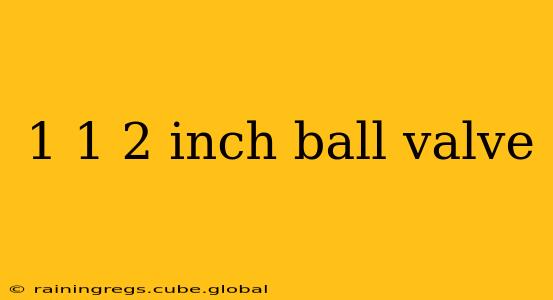Finding the right ball valve for your needs can feel overwhelming. This guide focuses specifically on 1 1/2 inch ball valves, exploring their applications, types, materials, and considerations for choosing the best one for your project. Whether you're a homeowner tackling a DIY plumbing project or a professional installer working on a large-scale system, understanding the nuances of 1 1/2 inch ball valves is crucial.
What are 1 1/2 Inch Ball Valves Used For?
1 1/2 inch ball valves, with their nominal diameter of 1.5 inches, are commonly used in various applications where precise fluid control is needed. Their widespread use stems from their simplicity, reliability, and cost-effectiveness. They're frequently found in:
- Residential Plumbing: Controlling water flow to appliances, fixtures, and irrigation systems.
- Commercial Plumbing: Managing water distribution in larger buildings and facilities.
- Industrial Processes: Regulating the flow of various liquids and gases in manufacturing and processing plants.
- Irrigation Systems: Controlling water flow to different zones in agricultural or landscaping settings.
- HVAC Systems: Controlling refrigerant or water flow in heating, ventilation, and air conditioning systems.
The versatility of 1 1/2 inch ball valves makes them a staple in countless applications requiring on/off or throttling control.
What are the Different Types of 1 1/2 Inch Ball Valves?
Several types of 1 1/2 inch ball valves cater to different needs and applications. Key distinctions lie in their design features and materials:
- Full-Port Ball Valves: Offer a completely unobstructed flow path, minimizing pressure drop and maximizing flow capacity. Ideal for high-flow applications.
- Reduced-Port Ball Valves: Have a smaller internal diameter than the nominal pipe size, leading to some pressure drop. They are generally more compact and less expensive than full-port valves.
- Three-Way Ball Valves: Allow for diverting flow to two different outlets, enabling versatile flow control and switching between different paths.
- Floating Ball Valves: The ball floats freely inside the valve body.
- Trunnion Ball Valves: The ball is mounted on trunnions (shafts) that provide better support for larger, heavier valves.
What Materials are 1 1/2 Inch Ball Valves Made From?
The material of a 1 1/2 inch ball valve is a crucial factor influencing its durability, corrosion resistance, and suitability for specific fluids. Common materials include:
- Brass: A popular choice for its corrosion resistance and affordability, suitable for potable water applications.
- Stainless Steel: Offers superior strength and corrosion resistance, ideal for demanding environments and aggressive chemicals. Different grades of stainless steel (e.g., 304, 316) offer varying levels of corrosion resistance.
- PVC: A lightweight and corrosion-resistant option, suitable for less demanding applications.
- CPVC: Chlorinated Polyvinyl Chloride offers higher temperature resistance and better chemical resistance than PVC.
How Do I Choose the Right 1 1/2 Inch Ball Valve?
Selecting the appropriate 1 1/2 inch ball valve involves considering several critical factors:
- Fluid Type: The valve's material must be compatible with the fluid it will handle to avoid corrosion or degradation.
- Pressure Rating: Ensure the valve's pressure rating exceeds the maximum pressure in your system.
- Temperature Rating: The valve must withstand the temperature range of the fluid.
- Flow Rate: Determine the required flow rate and choose a valve (full-port or reduced-port) that meets your needs.
- End Connections: Select the correct end connections (e.g., threaded, flanged, socket weld) to match your piping system.
What are the Common Sizes of Ball Valves?
Ball valves come in a wide range of sizes, from very small diameters to very large ones used in industrial pipelines. While 1 1/2 inch is a common size, you’ll also find valves in sizes like 1 inch, 2 inch, 3 inch, and even larger. The sizing depends entirely on the application and flow rate requirements.
What is the Difference Between a Ball Valve and a Gate Valve?
Both ball valves and gate valves are used for controlling fluid flow, but they differ in their design and operation. Ball valves use a rotating ball to control flow, offering quick on/off operation and usually a more compact design. Gate valves use a sliding gate to control flow, offering better throttling capabilities but potentially slower operation and a larger footprint.
How Much Does a 1 1/2 Inch Ball Valve Cost?
The cost of a 1 1/2 inch ball valve varies significantly depending on the material, type, brand, and features. Expect prices to range from a few dollars for basic PVC valves to several hundred dollars for high-pressure, stainless steel valves with specialized features.
This comprehensive guide provides a solid foundation for understanding and selecting the appropriate 1 1/2 inch ball valve for your specific application. Remember to always consult with a qualified professional if you have any doubts or concerns about your project.
